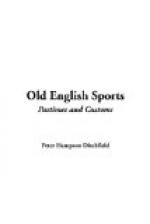In old churchwardens’ account-books we find such entries as the following—
“To the sextin for watching the sepulture two nyghts viii_d_.”
“Paide to Roger Brock for watching of the sepulchre 8_d_.”
And as the nights were cold we find an additional item—
“Paid more to said Roger Brock for syses and colles, 3_d._”
These entries allude to the ancient custom of erecting on Good Friday a small building to represent the Holy Sepulchre, and setting a person to watch for two nights in remembrance of the soldiers watching the grave in which our Lord’s Body was laid. At the dawning of the Easter morn the bells rang joyously, and all was life and animation. The sun itself was popularly supposed to dance with joy on the Feast of the Resurrection. But the manners and customs, sports and pastimes, which were associated with Easter, I will reserve for my next chapter.
CHAPTER IV.
April.
“The spring clad all
in gladness
Doth laugh at winter’s
sadness;
And to the bagpipe’s
sound
The nymphs tread out
their ground.
“Fie then, why sit we
musing,
Youth’s sweet
delight refusing;
Say dainty nymphs, and
speak:
Shall we play barley-breake?”
Old Ballad (A.D. 1603).
Easter Customs—Pace Eggs—Handball
in Churches—Sports
confined to Special Localities—Stoolball
and Barley-brake
—Water Tournament—Quintain—Chester
Sports—Hock-tide.
From the earliest days of Christianity Easter has always been celebrated with the greatest joy, and accounted the Queen of Festivals. Many curious customs are associated with this feast, some of which represented in a rude, primitive way the Resurrection of our Lord. There was an old Miracle Play which was performed at Easter; for we find in the churchwardens’ books at Kingston-upon-Thames, in the reign of Henry viii., certain expenses for “a skin of parchment and gunpowder for the play on Easter Day,” for a player’s coat, stage, and “other things belonging to the play.”
Then there was the custom in the North of England of “lifting” or “heaving,” which was originally designed to represent our Saviour’s Resurrection. On Easter Monday the men used to lift the women, whom they met, thrice above their heads into the air, and the women responded on Easter Tuesday, and lifted the men. This custom prevailed also in North Wales, Warwickshire, and Shropshire.
The Pace Eggs, or Pasche, or Paschal Eggs, were originally intended to show forth the same truth, as the egg retaining the elements of future life was used as an emblem of the Resurrection. These Pace eggs were dyed, decorated with pretty devices, and presented by friends to each other. In the North of England, the home of so many of our old customs, the practice of giving Pace eggs still lingers on; and we find amongst the household expenses of King Edward I. an item of “four hundred and a half of eggs—eighteenpence,” which were purchased on Easter Day. The prices current in the thirteenth century for eggs would scarcely be deemed sufficient by our modern poultry-keepers!




